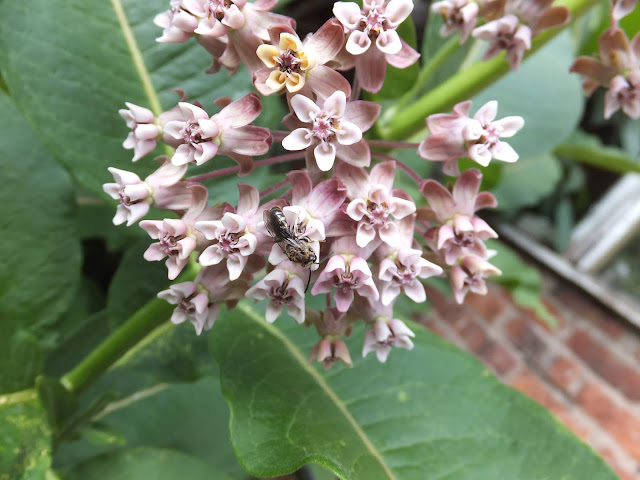I have a 5 metre by 5 metre garden. Rather than constantly adding annuals and tender bedding plants I believe in putting plants in the garden that are going to continue and increase for years. Which they have been, so it is now absolutely full.
Pictures after the break.
The plants in the first photograph include, from the closest to the camera:
- Three very mild chilis in pots.
- Two tomatillos (Physalis ixocarpa) in too small pots and falling over and being eaten by something. Just started setting fruit.
- A mixture of Salvias, Salvia glutinosa, Salvia nubicola and one that was sold as Salvia nubicola but is not. These are all closely-related and the self-sown ones nearer the camera may be a hybrid of any of the three.
- Common milkweed (Asclepias syriaca) at the front.
- Maitén (Maytenus boaria) behind and left, planted 2015 and now settled in and suckering.
- Salvia "Hot Lips" at the right.
- More of the hybrid Salvias behind.
The large straggling bush of Salvia "Hot Lips" that lost its leaves for the first time in the last long winter. It was late putting on new leaves but has now completely recovered.
The wrong Clerodendron trichotomum from Burncoose Nurseries. I wanted the intensely fragrant variety like that at Parsonage Gardens in Didsbury. Unfortunately this one is nowhere near as fragrant. They did have a variety with deep scarlet bracts at Burncoose but they don't seem to list it now. This one has pretty flowers like a white jasmine with a pale pink star of bracts behind each flower. It produces lots of them and they are probably opening soon. It grows very vigorously if fed. Be careful when using prunings as plant stakes - it roots very easily.
The milkweed (Asclepias syriaca) produces abundant flowers. Some varieties of this species are bitter to the taste and may be mildly poisonous due to interbreeding with other species in their native North America. This is a sweet one that I raised from seed from Rare Plants. When I bought them the seeds were under one euro. I sowed the seeds in 2014 and planted three out in 2015. The slugs got two before they established, so these plants are all one clone. After a few years settling in it is now spreading rather vigorously by rhizomes.
The flower buds are delicious when boiled, from three to five minutes is quite enough. The flowers produce so much nectar that if you keep the bees off you can shake the nectar out of the flowers. Native Americans used to boil the nectar down to make dry sugar.
In the evenings the flowers produce a delightful scent, quite powerful on some nights.
The bees love it.
Unfortunately the aphids love it, too. They can get very heavy infestations at the growing tips of the stems which can result in distorted growth. I have found that the best way to control these is to put a ring of vaseline on the stem of the plant, about one to two centimetres wide. This prevents the ants from getting to the aphids. The ants kill predators that would otherwise control the aphids. The ants do this because they feed on the "honeydew", the still sugar-rich product of digestion of sugary sap that the aphids excrete. Exclude the ants and the predators such as ladybirds, lacewings and hoverfly larvae quickly return.
Did I mention that the bees love it? There were many other varieties that did not sit still long enough to get a good photo.
I think this tiny bee is a Lasioglossum. Possibly a Lasioglossum leucozonium. This would make it one of the "sweat bees". For size comparison, the forward-facing part of the flower is about 1 centimetre across.


























